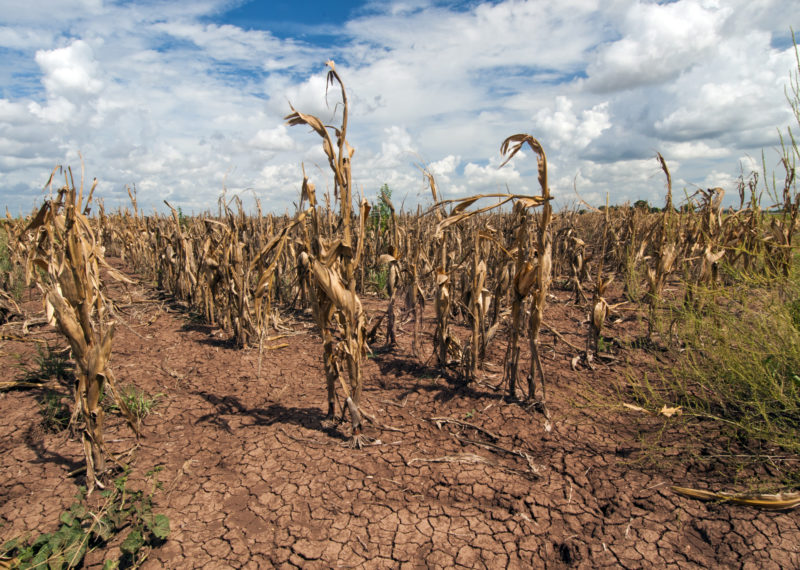Climate change threatens our food systems as we know them. Some 821 million people currently suffer from malnutrition worldwide, including 151 million children under five whose growth is stunted. A warming planet will put even more people at risk of hunger in the years to come, according to a recent Intergovernmental Panel on Climate Change (IPCC) report. In some places, it already is.
West Africa is suffering its worst food crisis in a decade, with some 27 million people going hungry due to droughts, conflict and the economic fallout of the pandemic, according to Oxfam International. Severe drought, combined with other factors like the war in Ukraine, also puts 28 million people in East Africa at risk of severe hunger, the aid group has announced.
Researchers are already observing crop failures, fish depletion as well as rising CO2 levels, which makes the food we do grow less nutritious. These factors, paired with conflict and more extreme weather “have led to increased acute food insecurity for millions of people,” says Rachel Bezner Kerr, a Cornell sociologist who studies food systems and agroecology.
Some adaptation methods which can have negative impacts —like irrigation that draws on groundwater during times of drought—can widen inequities and deplete resources in the long term. That’s why many researchers are thinking beyond technical solutions and incorporating community-led planning, Indigenous knowledge and local ecology in their adaptation planning. “It’s not a cookie-cutter approach, but [rather] designing a system that takes into account social,ecological and economic dimensions of the food system,” says Bezner Kerr.
Bezner Kerr, who was a lead author of the food chapter of the February IPCC report, which focused on climate impacts and adaptation, spoke to Nexus Media News about why we can’t innovate our way out of a climate-related food crisis, what are some existing inclusive adaptation strategies and why every increase in temperature puts more people at risk of going hungry.
This conversation was edited and condensed.
What are some of the specific ways that climate change is disrupting food supplies?
There is robust evidence of declines in total agricultural productivity on a global scale over the last 50 years that’s directly attributed to the impacts of global warming. There are also observed impacts on productivity in the oceans. It’s not just land-based impacts—it’s also marine and inland fishery populations, which is due to both ocean acidification and global warming.
There are also impacts on other dimensions of the food system, partly through climate-related extreme events, like heat waves, droughts and floods, which have led to food shocks—reduced food production and less diverse food stocks. Those events can also disrupt the infrastructure that supports the food system, leading to increases in prices.
All these factors have led to increased acute food insecurity for millions of people.
Your report focuses on adaptation. Can we innovate and adapt our way out of this crisis?
A technology-focused strategy that doesn’t take multiple risk-factors into account, that isn’t inclusive of marginalized groups and isn’t integrated with other sectors is not going to get us out of this problem. We need a significant reduction in emissions alongside a much more holistic, inclusive approach to adaptation.
We’re seeing a lot of autonomous adaptation, such as farmers switching crops or incorporating different management strategies, to account for some of the observed [climate] changes. But many of these adaptation strategies are incremental, single-risk focused and they’re not widespread. They’re not nearly at the scale that’s needed to transform the food system.
Adaptation strategies need to change significantly and become much more widespread, transformational, multisectoral and inclusive.

What do more inclusive adaptive strategies look like?
In an urban environment, we know that low-income households often have less access to green space and are at a greater risk of experiencing severe heat stress. We also know that more green spaces provide cooling and reduce energy [needs] for buildings. Gardens in low-income areas that actively involve local households in the planning can help produce more locally available, diverse food types, which can reduce the risk of malnutrition.
In rural areas, we know smallholder [farming] households are more vulnerable and often marginalized. They often have less of a political voice, and they depend on rainfall [as opposed to irrigation systems] for their food production. They may be at [greater] risk from an extreme event, whether it’s drought or, say, a pest outbreak—climate change brings an increased risk of pest and disease outbreaks.
We—policymakers, workers involved in agricultural extension and adaptation programs and even consumers—can provide more support for them to diversify their agricultural production, use farming methods that strengthen their soils and develop agroforestry systems so that animals have more shade during heat waves and droughts. We can also link them to homegrown school feeding programs, where local farmers produce diverse foods that go into local schools, providing a local market for farmers and healthy food for school children.
The report warns against “maladaptive” responses that provide short-term solutions to the effects of warming. What are some of those maladaptive responses?
One well-documented example is irrigation that draws on groundwater supplies. That provides short-term benefits to farmers who are using irrigation, but it can lead to depletion of groundwater resources; it can lead to salinization, which means that the soils, long term, aren’t very productive for growing food, and it can mean less available drinking water.
What’s more, if the program that is promoting irrigation doesn’t support lower income, smaller scale farmers, it can exacerbate inequalities between large landholders and smaller landholders, because large landholders often have more access to capital and irrigation.
Irrigation can be an effective strategy, but it needs to be carried out with consideration for the agro-ecosystem and the water resources available, as well as the economic and social dynamics in the region. Inclusive planning would make sure that smallholder farmers are not left worse off.
I was surprised to read about evidence of crops losing nutritional value due to climate change. Why is that occurring?
CO2 production for some crops can lead to an increase in yield, but mainly through increasing carbon and not increasing nutrient uptake. So it leads to decreased nutrient concentration. This has been observed in rice, wheat and soybean, but also in some fruits and vegetables.
This report emphasized a need to include Indigenous knowledge and solutions. Can you point to specific examples?
Perhaps the simplest example is Indigenous knowledge of a wide range of varieties of food [species]. There has been some exciting research [that has resulted from] working with farmers in the Andes. They’ve maintained a wide and diverse range of potatoes that are able to live under different, difficult conditions.
We’ll need to draw on this knowledge and work with Indigenous producers to address the biodiversity crisis and adapt to more difficult conditions, like drought.
What’s the most important takeaway from your chapter?
Every increase in temperature matters for putting all of us and the food system at greater risk. We know from our assessment that certain regions of the world—Africa, South Asia, Central America, the Arctic and small islands—are at greater risk, but we also know that all of us are at risk.
This isn’t something you can close your eyes to and think this is affecting other people around the world. This is affecting all of us. This includes food prices, disruption of our food systems and availability of different foods. So, in addition to having concern for other parts of the world, it’s also going to be hitting home.
We know that even within less vulnerable areas, such as North America, certain groups are at greater risk from climate impacts within the food system. These include smallholder farmers, but also Indigenous peoples, minorities, low-income households, elderly people, children, pregnant women. It’s a long list.
Again, no one has been spared from climate impacts. That puts the onus on us to act now to reduce the severe severity of this going forward for everyone.
This article was made possible by a grant from the Open Society Foundations. Nexus Media News is an editorially independent, nonprofit news service covering stories about climate change. Follow us @NexusMediaNews.


